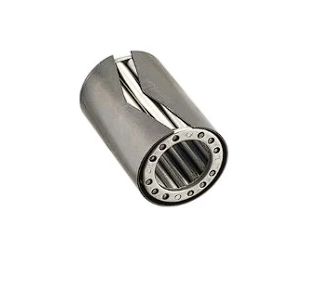
Roller Bearing vs. Ball Bearing: What's the Difference?
The smallest elements can sometimes make the biggest impact when using furniture and equipment in different commercial and industrial environments. For instance, roller and ball bearings in caster wheels make transporting heavy items across multiple surface types easy. Though it might appear as though these bearings are the same, they're vastly different and suitable for specific applications.
Which is best in the roller bearing vs. ball bearing debate? Our team at Caster Central has decades of experience producing many kinds of caster bearings and knows how confusing it can be to determine which bearing type is ideal for a specific application. Get clarity about the similarities and differences between roller and ball bearings in our guide below.
Don't hesitate to contact us if you need a specific caster bearing type for your business equipment.

What Are Ball Bearings?
Before going into a roller bearing vs. ball bearing discussion, you should know what both mechanical bearings are to fully comprehend their differences and applications.
Industrial ball bearings have outer and inner rings with a series of steel balls and a cage to ensure even spacing between the balls inside the rings. Both rings could be steel, ceramic, or another durable material designed to withstand heavy loads and high speeds in material handling applications.
The balls inside the bearing create low-friction contact points with the outer and inner rings. As a result, the bearing can move without much resistance or energy consumption. In other words, the ball bearing design makes it easy for items to glide over a surface with even load distribution.
Typical applications for ball bearings are:
-
Electric motors
-
Car engines
-
Power tools
-
High-speed tooling equipment
Types of Ball Bearings: A Deeper Look
Deep Groove Ball Bearings for High-Speed Applications
Deep groove ball bearings are designed for high-speed rotation and are suitable for lighter loads, making them ideal for applications such as electric motors and high-speed tools.
Thrust Ball Bearings for Axial Loads
Thrust ball bearings are specifically designed to handle pure axial loads, which are commonly found in applications like industrial conveyor systems and screw drives.
Pros and Cons of Ball Bearings
Ball bearings offer incredible versatility since they can move on more than one axis. They can accommodate applications with pure radial loads like gearboxes and machine shafts, pure axial or thrust loads like industrial conveyor and screw drive systems, or any load combination.
Ball bearings don't produce much friction because they don't have a large contact area for the load. As a result, they're great for applications where smooth movements at higher speeds are necessary.
Unfortunately, the lack of surface area makes ball bearings unsuitable for heavy loads. They function best in applications that require light loads and speed.
What Are Roller Bearings?
When considering that roller bearings also create smooth movements like ball bearings, the roller bearing vs. ball bearing discussion might seem unnecessary. However, industrial roller bearings don't use a set of durable balls to facilitate motion. Instead, they use cylindrical rollers to reduce friction between the bearings and whatever surface they encounter.
The rolling element of this bearing sits between the inner and outer rings. Because of the size and nature of the cylindrical roller, it has a greater contact surface area. Like ball bearings, the cylindrical rollers have even spacing with a cage to maintain their positioning.
This design gives roller bearings an excellent load capacity with improved radial and axial performance. You'd usually find these bearings in applications and industries like:
-
Agricultural equipment
-
Mining
-
Construction

Types of Roller Bearings
Tapered Roller Bearings for Heavy Radial and Axial Loads
Tapered roller bearings are designed to manage heavy radial and axial loads, making them ideal for demanding applications in construction and mining equipment.
Spherical Roller Bearings: Handling Shaft Deflection and Misalignment
Spherical roller bearings are specifically engineered to accommodate shaft deflection and misalignment, ensuring smooth operation even under heavy loads.
Cylindrical Roller Bearings for High-Speed Rotation
Cylindrical roller bearings are ideal for relatively high speeds because the cylindrical elements inside the bearing produce minimal friction. These bearings are often used in combination with angular contact ball bearings in machine spindles.
Needle Bearings for Higher Load Capacity
As a variant of cylindrical roller bearings, needle bearings have long rollers with a smaller diameter relative to their length. The increased surface area allows these bearings to accommodate greater load capacity without requiring more clearance.
Pros and Cons of Roller Bearings
Roller bearings don't have to be cylindrical. They're also available in other forms like spherical, needle, and tapered shapes to work in more applications.
With the increased surface area, the rollers can support heavier radial loads. Roller bearings also offer exceptional durability, so there's little to no worry about heavy loads damaging them. However, they're bigger, so they're best for machinery and equipment with enough space to accommodate them.
A downside to using industrial roller bearings is friction. Roller bearings take on a little more friction than ball bearings despite their limited movements with radial loads. The extra friction may require additional maintenance to keep the roller bearings in good condition and prevent the need for premature replacement.
Understanding Load Dynamics in Bearings
Radial and Axial Loads: Key Considerations in Bearing Selection
Radial and axial loads are fundamental forces that bearings must handle, and understanding how these loads affect bearing performance is crucial in choosing the right bearing type for your application.
Thrust Load vs. Radial Load: When to Use Thrust Bearings
Thrust bearings are specifically designed to handle axial loads, making them ideal for applications where these forces are predominant, unlike radial bearings that handle loads perpendicular to the axis of rotation.
Bearing Construction and Performance
Inner and Outer Races: The Backbone of Bearing Durability
The inner and outer races are critical components in both ball and roller bearings. Their design impacts load distribution, bearing longevity, and overall performance, especially under heavy load conditions.
Bearing Races and Friction: Point Contact vs. Line Contact
Ball bearings have point contact between the balls and races, while roller bearings have line contact. This difference in contact type significantly affects friction levels and the load-carrying capacity of the bearing.
Specialized Bearing Applications
Self-Aligning Ball Bearings: Minimizing the Impact of Shaft Deflection
Self-aligning ball bearings are designed to correct issues caused by shaft deflection or misalignment, making them suitable for heavy machinery where these problems are common.
Spherical Rollers: Managing Heavier Loads with Stability
Spherical roller bearings excel in applications that involve heavy radial loads, providing stability and durability in challenging environments like mining and construction.
Performance Comparisons
Friction Compared: How Ball and Roller Bearings Perform Under Pressure
Comparing the friction levels of ball and roller bearings reveals that ball bearings generally offer smoother operation with less friction, making them ideal for high-speed applications, while roller bearings excel in high-load situations.
High Rotational Speed vs. Higher Load Carrying Capacity
Ball bearings are often chosen for high rotational speed applications due to their low friction, while roller bearings are preferred for their higher load-carrying capacity, particularly in heavy-duty industrial applications.
The Difference Between Roller and Ball Bearings
If you need bearings for an application that demands speed but doesn't have a heavy load, ball bearings are likely the best choice. On the other hand, roller bearings are best for heavy-duty applications with shocks.
Manufacturers frequently sell ball bearings as assemblies. When it's time to replace them, you'd need to replace the unit, not individual parts. Roller bearings are different; you can replace the inner and outer rings individually if necessary.
Because ball bearings are versatile, the single-row bearing style is the standard. You can use them in various applications regardless of manufacturers. However, roller bearings don't have a specific standard, so particular applications will require a specific bearing brand, type, size, and so on.
Another difference between ball and roller bearings is the possibility of usage following the misalignment of a roller element. For example, ball bearings could still work if a ball has an angular misalignment up to 0.004 inches between the bearing and the shaft. Roller bearing misalignments are less forgiving and could stop functioning correctly if a roller falls too far out of place.
Heavy-Duty Applications: When Roller Bearings Are the Better Choice
Roller bearings are ideal for heavy-duty applications where higher load capacity and durability are essential, particularly in industries like construction, mining, and agriculture.
Get the Caster Bearings You Need From Caster Central
No matter your thoughts regarding the roller bearing vs. ball bearing discussion, Caster Central is the go-to destination to acquire either. We offer a wide range of wheel and material handling products and accessories, from cylindrical roller bearings to various mount types of caster wheels.
Caster Central has over 150 years of experience as an industry leader. We provide caster-bearing solutions for any personal, commercial, or industrial use and back our products and services with a 100% satisfaction guarantee. Our knowledgeable and well-trained team is ready to help you in any way. Call (800) 445-4082 today to inquire about our Caster Central products.